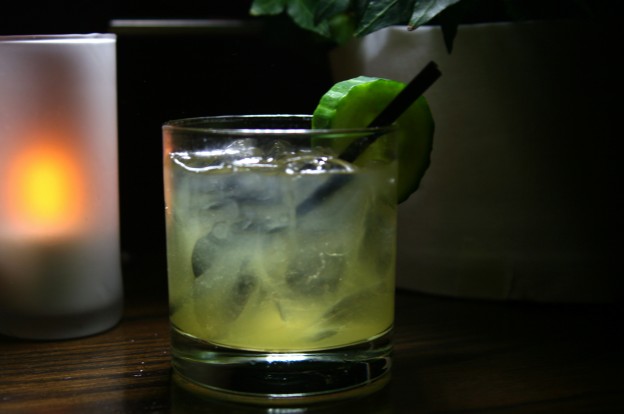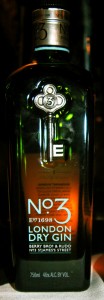Martini. Do you think vodka? Gin. Stodgy old men? Time to catch up on the latest in your city’s mixology and drink culture.
After WWII, clever marketing and advances in distillation made vodka, neutral and versatile, the king of the cocktail menu. But over time, bartenders and cocktail drinkers have found that only so much can be done with vodka’s bland flavor profile. A new indifference to vodka, alongside a classic cocktail revival, is thus to the benefit of America’s long lost favorite spirit: gin.
Maybe it has to do with our nation’s new obsession with prohibition-themed T.V. dramas, documentaries and faux-speakeasies, or maybe it’s just the natural cycle of things; either way gin, with its subtle nuances of juniper, botanicals and spices, has piqued the interest of the nation’s top mixologists and bartenders.
Timing, therefore, is more or less perfect for the Stateside launch of No.3 London Dry Gin, a creation of London’s oldest wine and spirit merchant Berry Bros. & Rudd (est. 1698). BB&R has been a family-run endeavor for eight generations and still inhabits the shop that gives name to their gin: No.3 St. James’s Street. The brand has been picked up by the Anchor Distilling Company in San Francisco, which specializes in selling craft-distilled, family-owned artisanal spirits steeped in tradition and storytelling. Successful in London, No.3 is now seeking to garner the attention of influential American bartenders and mixologists.
One such bartender, Jackson Cannon of Eastern Standard in Kenmore Square, helped organize No.3’s introduction to the Boston bar scene with a cocktail party at the restaurant this past Thursday night. No. 3 London Dry Gin is smoothly drafting not only behind a gin resurgence, but also behind the rise of boutique spirits on drink menus such as Cannon’s (see Susanna Bolle’s posts from PRK’s “Meet Your Bartender” series). There is a growing sense that the story and tradition behind a spirit foretell the quality of the final product. Thus, for small producers marketing a new brand, finding a way to tell that story to consumers is often as important as getting them to taste it.
No. 3’s story is actually an interesting lesson in the history of distillation, gin and the flavor industry. Modern-day gin was invented by a 17th-century Dutch physician, though records show that distilling juniper berries — highly-regarded for their supposed medicinal properties — had been in practice for centuries. (Juniper, in fact, is not a berry, but a cone that gives high-quality gin its distinctive pine aura.)
Much of gin’s success throughout history is due to the ease in which it can be made. For a long time in English history, the spirit was associated with the poor and drunkards. During America’s Prohibition “bathtub gin” was a widely-available alcohol in speakeasies and in people’s homes. However, the invention of London Dry Gin in the 19th c., with its triple distillation, predominant juniper flavor and lack of sugar, successfully allowed gin to be redefined as the “gentlemen’s choice.”
Back to the present-day. BB&R wanted to recapture the tradition of true “Gentlemen’s” London Dry Gin. With this in mind, they called Dr. David Clutton, the only Gin Ph.D in the world, out of his retirement in the English countryside. (Now you know what you want to go back to school in.) Together they came up with a mixture of three botanicals and three spices to flavor No. 3 in the distillation process — in other words, a simplification of their London Dry competitors’ processes, which often include up to 20 different flavor profiles.
The creators of No. 3 wanted a discerning taster to be able to differentiate between their six ingredients: Italian juniper, sweet Spanish orange peel, grapefruit peel, angelica root, Moroccan coriander seed and cardamom pods.
Next was the matter of production. Small producers often face a problem with consistency in their batches, sacrificing overall quality. To solve this, the creators approached the second oldest distillery in Europe, whose heritage matched that of BB&R, conveniently located in the fabled birthplace of gin, Holland. The Dutch distillers still used an old-school pot-distillery method that fit well with the makers goal to recreate a traditional London Dry craft gin. “We love the fact that we’ve done something really simple” King continued, “And we are the underdog. In England, we love the underdog, and I think Americans do, too.”
Now you’ve got the history. And you know that gin is trending. Still not sold? We’ve listed some of the Berry Bros. & Rudd’s gin drinks that premiered last Thursday at Eastern Standard so you can put your own discerning palate to work:
Piccadilly
The iconic cross street where St. James Street starts, home of No.3 Gin, which runs through central London. This cocktail uses two of London’s most notable spirits No.3 Gin and Pimms, refreshing and tart, a perfect accompaniment to fish and chips.
1 ½ oz No.3 Gin
1 oz Fresh Lime Juice
¾ oz Simple Syrup
½ oz Pimms
1 Barspoon Luxardo Amaretto
4-5 Basil Leaves
Combine ingredients into a mixing glass, add ice and shake until properly diluted. Double strain into a lowball over fresh ice, garnish with a cucumber wheel.
Mind the Gap
A saying held dear to travelers in London, because it may save your life! Pulling the layers of flavor from the gin was the goal of this cocktail, using the aromatics from the vermouth, grapefruit and cardamom.
1 ½ oz No.3 Gin
¾ oz Fresh Grapefruit Juice
¾ oz Sweet Vermouth
½ oz Cardamom Syrup
2 Dashes Angostura Bitters
Combine ingredients into a mixing glass, add ice and shake until properly diluted. Strain into a chilled coupe glass, no garnish.
King’s Toddy
Named for the King George III, who was first supplied with the Berry family legacy. Fresh lemon and ginger connect with the aromatics of the spirit; the orange oil brings out the Spanish orange of the gin.
1 oz No.3 Gin
¾ oz Fresh Lemon Juice
½ oz King’s Ginger
½ oz Clover Honey Syrup
Combine ingredients into a hot mug, top with hot water and garnish with a rough orange twist.



The juniper used in gin is actually a berry that turns green to purple as it ripens. Gary Regan’s gin book is a good place to read more as well as looking at Alcademic’s Camper English’s experiences harvesting these berries for gin:
http://www.alcademics.com/2011/06/picking-juniper-berries-in-tuscany-a-photo-album.html
Pingback: This Week in Cocktails: November 6 – 12, 2011 « All Hail the Cocktail